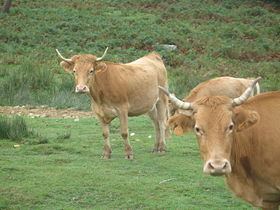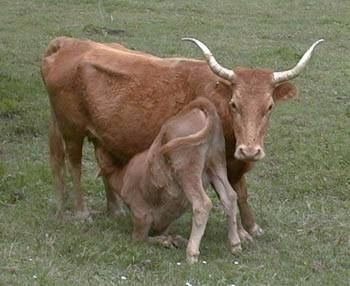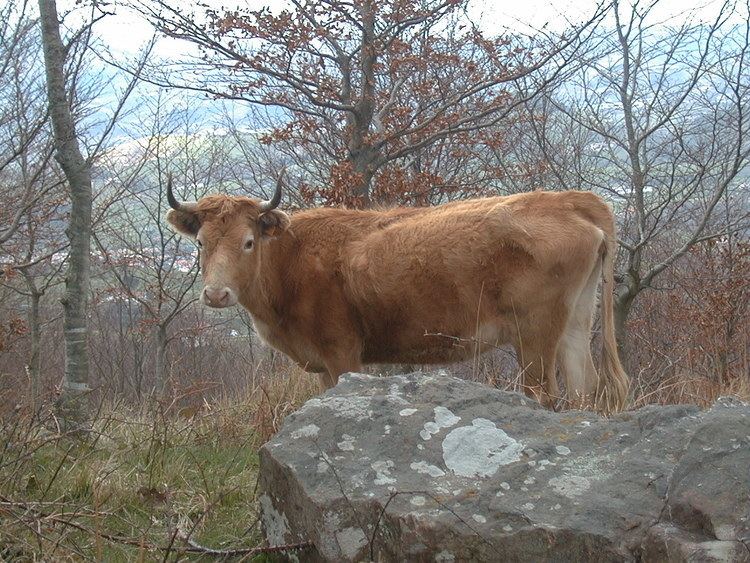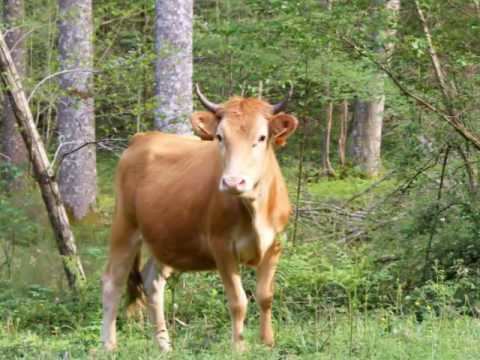 | ||
Similar Aure et Saint‑Girons, Ferrandaise, Armorican cattle, Bleue du Nord, Ennstaler Bergscheck | ||
Gora gora betizu betizu taldea
The Betizu is a breed of feral cattle that is autochthonous to northern Spain and the French Basque Country. The breed enjoys protection status from the Spanish Ministry of Agriculture, Fishing and Feeding, and the French Conservatoire des Races d'Aquitaine [Conservatory of the Aquitaine Breeds].
Contents
- Gora gora betizu betizu taldea
- Betizu taldea lokaleko leihotik
- Etymology
- Morphology
- History
- Populations
- Navarre reserve
- In popular culture
- References

Betizu taldea lokaleko leihotik
Etymology
The name betizu derives from the Basque behi izua: "elusive cow".
Morphology

Thin, short, covered by abundant unruly hairs; expressive eyes surrounded by a light aureole; highly developed mane with slightly curved white horns (especially in females); short neck of medium thickness, characterized by an abundant dewlap; the upper line of the neck is straight in females and swayed in males.

The thorax is more pronounced in males than in females. With slightly arched ribs, saddled and ascendant back, and a lumbar legion of poor muscular development.
The hindquarters are underdeveloped, showing the bony prominences. With an upper tailhead continued by a long tail.
Straight and underdeveloped
Medium length lower legs and well-developed joints. Small hard light-colored hooves.

Reddish-brown hair, with seasonal and gender variations; variations in color near the end of the feet, the nose, and the ocular aureole. Thick yellow-to-white skin with pink depigmented mucosa.
This animal lives in a free environment and its elusive behavior matches to these conditions.

Height between 1.1 to 1.3 metres (3.6 to 4.3 ft); weight from 325 kilograms (717 lb) in females to 450 kilograms (990 lb) in males
History
The betizu occupies a place in the mythology of the Basque people under the name of Zezengorri ("red bull"). It is found among the stories of other such animals as the behigorri, txahalgorri, ahatxegorri and idigorri which guard the caves in which are hidden the treasures of Mari.
The betizu has also been known by different authors and in different locations as the "vaca del país", "casta navarra" and "raza vasca". José Miguel de Barandiarán has referred to it as the "vaca huraña".
Populations
As of 2013, the number of individual in Navarra was estimated at 254; while the numbers in Aquitaine were put at less than 150.
Navarre reserve
The Government of Navarre has launched a project to conserve this autochthonous breed. They own a herd that inhabits the abandoned village of Sastoya, in the Urraúl Alto valley. The stated goal of the project is to protect and expand this breed.
The Sastoya village encompasses more than 80 hectares (200 acres), of which 12 hectares (30 acres) are grasslands. It is inside the area of Ecological Production and is property of the Government of Navarra. It is managed by their Environment Department. The facility includes several warehouses to manage the livestock.
The Sastoya reservation houses about 45 animals. Reservation workers limit their contact with the animals in order to preserve their wild nature.
In popular culture
The Betizu has recently become popular because a Basque language children´s program Betizu broadcast by ETB 1. The show aims to spread awareness of the animal and the conservation efforts ongoing on its behalf.
